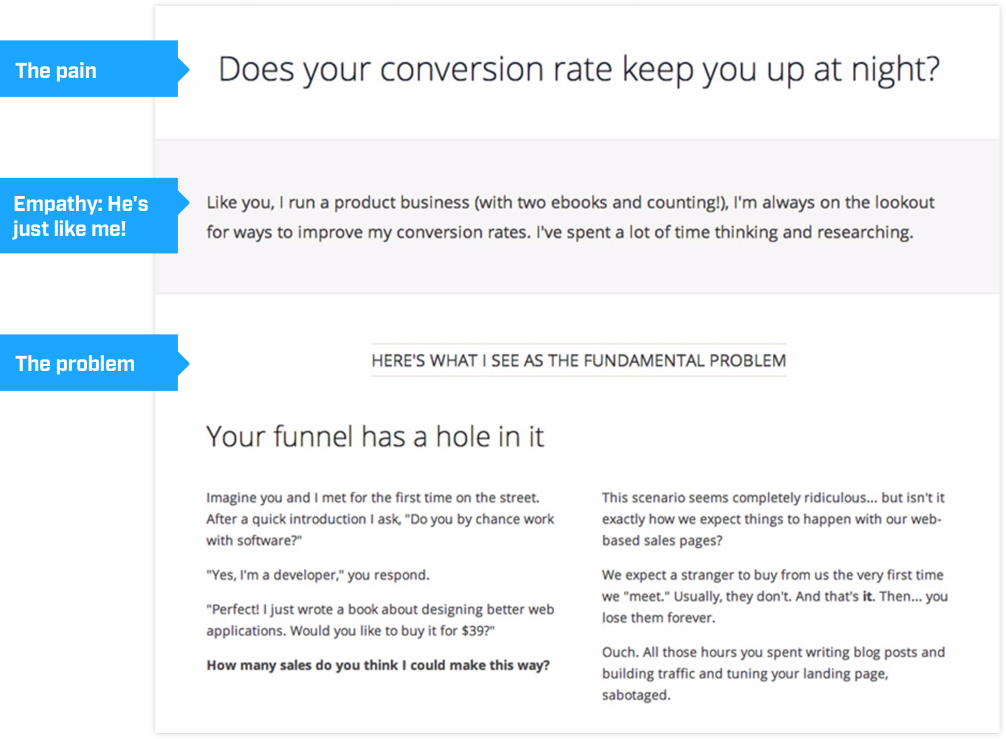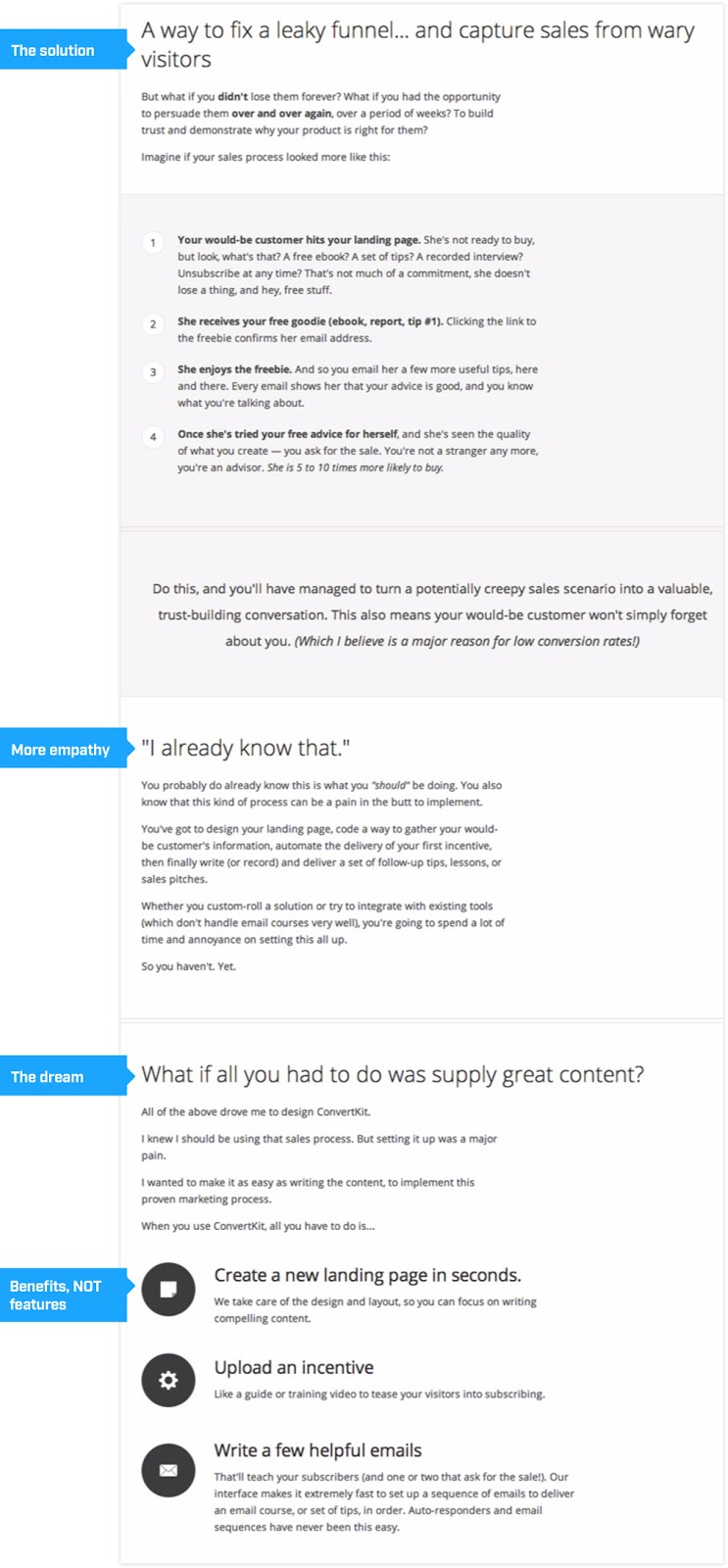How to market your company without alienating your customers


I remember my first marketing internship. I spent most of my time blasting out pitches and posting indiscriminately to every social media platform until my wrists were sore.
My boss thought I was fantastic. Six years later, I realize my brute force approach was dead wrong. I was throwing time and money down the drain, and making my brand look like the JV team. Sound like your marketing plan?
There’s good news: These bad habits aren’t hard to break. The first step is awareness, and that starts right now. Below, we’ll look at the most common marketing mistakes and how to fix them — and quickly.
Mistake #1: Talking About Yourself
There’s something that most highly likable people have in common: They don’t spend very much time talking about themselves. Instead, they listen and love to ask questions. Most of all, they genuinely care about what you have to say.
This is pretty basic stuff. Yet companies prattle on and on about themselves and how great their products are and expect people to follow, like, and buy.
Fact: If potential customers don’t care about you, they won’t care about your products or services.
What people do care about is how you can help or entertain them.
“When you provide value and are interesting in the process,” says David Meerman Scott, author of The New Rules of Marketing and PR, “people will line up to learn more about what you have to offer.”
Take HubSpot, a marketing automation software company that went public eight years after launching. A huge contributor to its growth is a free tool called Website Grader.
Type in your URL, and Website Grader generates a free, customized report that not only rates your online marketing (social media mentions, blog post shares, basic SEO, and so on) but also provides you with actionable tips on how to improve. The tool is free, and it’s extremely valuable for HubSpot’s core audience, which is why it works. And it generates tens of thousands of business leads for HubSpot every month.
Your play: Create truly phenomenal, unique content
Your mission is to create 10x content for your site. That means content that’s 10 times better than the best result that can currently be found in Google search results.
To do so, it’ll have to meet the following criteria:
- It’s visually appealing on any device.
- It’s some combination of high-quality, trustworthy, useful, interesting, and remarkable.
- It’s considerably unique in scope and provides more information than what’s currently out there on the topic.
- It elicits emotion, such as admiration, joy, or gratitude.
- It solves a person’s problem or answers a searcher’s question in a comprehensive, accurate, and exceptional way.
- It’s presented in an unexpected way.
This sounds like hard work because it is. But it’s the only way to win in the era of peak content.
Here’s a four-step process you can use to create it:
Step 1: Find a phenomenal idea
The creative process varies for everyone, but here’s how I generate story ideas.
First, I use Pocket’s explore feature or Recommended tab to see how many times a blog post has been saved. This is a really clear indicator of whether a lot of people think a topic or headline is worth reading.
Next, I visit niche industry voting sites that curate the best daily articles from around the Internet, such as Inbound.org or Hacker News, to collect more popular content.
I also browse Medium’s Top Stories and click on popular article tags to see what rises to the top. I also subscribe to weekly curated newsletters (check out Newsletter Stash) that are relevant to my audience.
Finally, after reading everything I find, I narrow down my ideas by asking the following questions:
- Has this idea been covered in-depth already -- to the extent where I feel like I can’t bring new (and a hefty amount of) value to the topic?
- Is this timely?
- Are people sick of reading about this already? Are there lingering opinions to be answered or little-known, unpublished solutions to be shared?
- How difficult will this be for me to write?
- What will readers learn from this post? Or what will they feel after having read it?
- Does this topic have the potential to be meaty and insightful? Or will you just be writing a bunch of fluff?
- Is the idea unique and not covered by the mainstream outlets yet?
You can also validate your idea with an SEO tool, such as SEM Rush. Look for long-tail keywords with low-to-medium SERP difficulty and a decent amount of search volume.
Finally, visit Buzzsumo, Moz or socialcount.io to see how popular a link was or the most popular links on blogs in your industry or niche.
Step 2: Conduct in-depth research
Once you’ve selected a topic, browse the top search engine results and then ask yourself the following questions for each:
- What questions are answered?
- How do you rate the user experience?
- How thorough do you consider the information provided? Is it too detailed? Not enough information?
- What do you think of the visuals? Are they using stock photos or original art? Do the images accentuate the points being made? Do they use images to communicate complex data well?
- Does the piece provide you useful, actionable takeaways?
- How good is the writing? Does it speak to you or over you?
- Was there anything that you just wish was included but was not?
Step 3: Identify your secret sauce
So where’s the gap? Find it and develop a piece of content that fills it. How will you present unique data, exclusive interviews, or a controversial opinion to stand out from what’s already been done?
Step 4: Generate a powerful way to present your content
Now, publish your content in a beautiful, high-quality way because a beautiful design will increase time on site, the number of social shares, and decrease bounce rate.
As for images within a post, keep best practices in mind:
- Stick to a theme.
- Don’t mix and match. Use illustrations, or use real images, but don’t use both in the same post.
- Utilize online resources, such as Canva (free visual creator), Sketch (cheap and easy-to-use version of Photoshop/Illustrator for Mac) and DepositPhotos (download vectors and images) or Unsplash (free, beautiful images).
Mistake #2: Selling Products, Not Solutions
According to Chartbeat founder Tony Halle, you have 15 seconds to catch the average website visitor’s attention. Prospects want to hear about how you are going to solve their problem, not about your history or the services you provide.
“Often, customers don't even know what they need,” says Kelsey Jones, executive editor of Search Engine Journal. “All they know is they have this problem that they want someone to solve.”
The best sales pages rarely mention the product, and when they finally do, it’s toward the end. In the beginning -- or during those initial 15 seconds -- your only goal should be getting visitors to keep reading. You do this by painting a vivid picture of the problem your visitor is experiencing.
After you show that you “get them,” paint a beautiful picture of life without this problem -- one that makes them keep scrolling to learn more about the benefits they could experience if they had your solution.
Finally, show how you can help visitors. And then, and only then, talk about your products.
Your play: Focus on your prospects
ConvertKit is a prime example of compelling landing page copy.

Notice how each sentence makes you keep reading.
First, the writer grabs attention by asking a question the target audience will relate to. Then he not only shows them that he is just like them and therefore understands what they’re feeling, but he also explains why they should trust him -- because he’s spent a lot of time researching this problem.
Next, he presents the solution, goes on to detail the dream, and finally mentions his product and its benefits -- not its features. The key is to focus on the pain until visitors are thinking, “Yeah, this really is a massive problem!”
Your turn: Write out your prospect’s top three pain points and then what life would be like without them (dreams). How can you help those dreams come true (benefits)?
After you map those out, write your copy. Then, and only then, should you move onto designing your website or landing page.
Mistake #3: Gaming the system
Want to know the difference between a good marketer and a bad marketer? Ethics.
A good marketer earns subscribers. A bad marketer scrapes them.
A good marketer writes 10x content that emphasizes his or her expertise and generates quality leads. A bad marketer writes a clickbait headline that leads to a keyword-stuffed post that provides little value or entertainment.
Any time a new marketing tactic shows up, companies rush to exploit it. This creates an inevitable race to the bottom, which often destroys the tactic, says Shane Snow, founder of Contently and author of Smartcuts. Take those “around the web” links you see at the bottom of just about every article on the Internet.
Once marketers discovered those got high click-through rates (CTRs), we got a glut of misleading headlines, salacious photos that don't match the content being advertised, and marketers disguising product pitches as real news. And now publishers are getting rid of those links, Snow says.
And before marketers exploited publishers’ sites, black hat SEO scammers exploited Google itself until the search engine discovered and deleted its entire network of sites.
Your play: Focus on the human, not the hack
You won’t fool Google -- at least not for long. So your play is to write good stories with honest headlines that market non-deceptive products, says Snow.
In other words, meeting consumer expectations plays well on Google. No, you won’t land on page one overnight, but your efforts will be rewarded in the long run.
When you produce phenomenal content, people identify your brand as valuable, helpful, informative, genuine, and transparent. Also, if you do things the right way, you won’t have to worry about how Google or Facebook is tweaking their algorithms, disrupting your business overnight.
Mistake #4: Trying to be everywhere
I’ve had prospects -- usually someone who’s never done a day of marketing in their lives -- come to me and tell me exactly what they need done and how long it should take me to do it.
Their pitch typically sounds like this:
“We need to be on Facebook, Twitter, LinkedIn, Google+ (I heard it’s good for SEO), Pinterest, Snapchat, Instagram, and we also need to blog five times per week. We’re a startup, so you won’t get a budget yet, and you’ll have to do all of this yourself. Oh, and we needed this done yesterday so we’ll need you to just dive in. Forget the strategy.”
Let me be clear: Trying to be everywhere will get you nowhere. In fact, it’s a surefire way to get nothing accomplished and never meet your goals.
Imagine an early-stage SaaS startup with five employees, suggests Aaron Agius, CEO of Louder.Online.
“Even if one person is dedicated to marketing -- which, if you've ever worked at a startup before, you know would be unlikely -- do you really expect one person to juggle social media, content marketing, email marketing, paid ads, PR, referral marketing, and influencer marketing?”
Your play: Master the key channels
The smartest business owners hire good marketers, and trust them to do what is best for their company. This includes letting marketers tell you which channels to focus on and when. Here’s how you should go about choosing:
Consider your schedule, resources, and audience
How much time do you or the person you hired have to manage these channels? Is this your or their sole responsibility?
Next, be realistic about what resources you have, including skillsets and budgets. If your audience is on Pinterest and Instagram, then you’ll need marketers who are good at creating visual content or a budget to outsource design.
Stalk your audience
Where is your audience hanging out? Wherever that is, you want to be there. If you haven’t created buyer personas yet, check out your top competitors and even non-competitors that have the same target audience as you.
Where are they spending their time online? Which social channels are they on? Which ones get the most engagement? Buzzsumo can help with this. So can Brandwatch Analytics. And you could always just ask them via email or a poll on your website.
Don’t assume Facebook is required
While Facebook is the largest social network with the most active users, it’s also very noisy. So unless you have the resources to pay for ads (which I highly recommend, if you do), your content is not likely to show up in users’ news feeds. Most business pages can expect less than 10 percent organic reach.
Align your content with your platforms
The different networks require different types of content. Here’s a guide:
- LinkedIn, Slideshare, Twitter, Niche forums: Industry news, whitepapers, and company updates
- Snapchat, Facebook, YouTube, Instagram: Videos
- Instagram, Pinterest: Images
- Medium, LinkedIn: Editorial content
The bottom line: Marketing is about doing the right thing
Recently, a distraught business owner reached out to me after the SEO company he hired landed him a Google penalty. His site was wiped from the first page of search results overnight. Poof.
He was blindsided, because the company’s pitch sounded awesome. They had the inside scoop on how the Google algorithm worked, they claimed, and would optimize content to rise to the top of search results. And it worked, until it didn’t. He asked me what I would do differently.
“Do you have great products and services that are priced fairly?” I asked.
“Yes.”
“Do they solve real problems in ways your competitors can’t?”
“Of course,” he responded.
Even the best marketing technique will fall short if the core offering isn’t there. Never rely on SEO or some other marketing as a silver bullet — and that’s exactly what I told the business owner I would do.
“Then what I will do differently,” I explained, “is let your products, services, and character speak for themselves.”
If you like this post, you'd love my Ultimate Guide to Habits
It’s one of the best things I’ve published (and 100% free), just tell me where to send it: